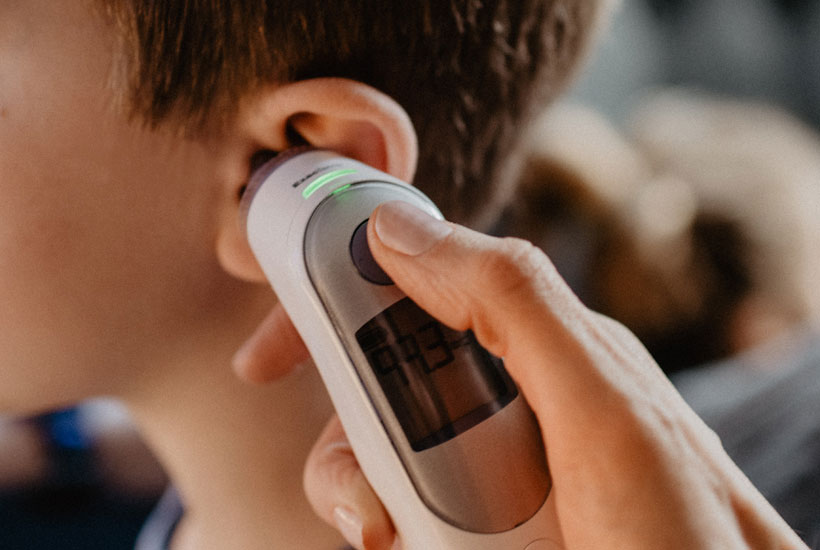A fever is a transient rise in body temperature caused by an illness or infection, indicating something unusual is happening in your body. That said, fevers are pretty uncomfortable, but there’s usually nothing to worry about unless it reaches 103 F (39.4 C) or higher, in which case, you must seek medical attention immediately. A modestly increased temperature in infants and toddlers may suggest a dangerous infection. Fevers usually go away in a few days. If you’re wondering how to get rid of a fever, or at the least ease fever symptoms, we delve into the best methods of easing the symptoms in this article.

Symptoms of a Fever
A fever is frequently associated with other symptoms such as: Sweating or shivering, feeling cold while your temperature is high, a painful headache or nagging headache, muscle aches, and lack of appetite. However, other symptoms can include skin rash, general fatigue and weakness, and exhaustion. The symptoms will vary according to the severity of the fever. And symptoms such as skin rash and muscle aches should be treated as standalone symptoms, even though they will subside with fever easing methods.
Causes of a Fever
Fever happens when the hypothalamus, a section of the brain, raises the set point of your normal body temperature. When this happens, you may feel cold, and you may begin shaking to generate more body heat. This eventually leads to a rise in body temperature. A variety of disorders can cause a fever. Among the potential causes are infections such as the flu and pneumonia, some vaccines, such as diphtheria or tetanus (in children), teething (in infants), several inflammatory disorders, such as rheumatoid arthritis (RA) and Crohn’s disease. Also, clots in the blood, sunburn to the extreme, food poisoning, and several drugs, including antibiotics, can all potentially cause a high fever.
Taking Your Temperature
Use a thermometer that has been cleansed in cold water, cleaned with rubbing alcohol, then rinsed to remove the alcohol. Do not consume food or drink for at least five minutes before the procedure. During this period, you should keep your mouth shut. Insert the thermometer tip beneath the tongue or underarm for small children. For around 40 seconds, hold the thermometer in the same place.
During measurement, the F (or C) symbol will flash, and the readings will continue to rise. When the final reading is complete, the thermometer will produce a beeping noise for roughly 30 seconds. If you’re keeping track, make a note of the temperature and the time. Rinse it again after cleaning it with alcohol.
Home Remedies
Although a fever is an indication that your body is fighting an infection, certain over-the-counter medications push your body to calm down to an average temperature. Rather than reaching for the medication cabinet, try a natural treatment. These methods can help to reduce your fever gradually. When you have a fever, sit in a bath of lukewarm water to cool down. You can also make use of a cold compress on your forehead to subside the high temperature.
When you have chills, wear light clothing and avoid using too many extra blankets. Also, drink plenty of cool or room-temperature water. Applying a cool, damp washcloth to your forehead and the back of your neck can assist. Ginger’s antibacterial properties are excellent for fever relief; drink it with water, juice, or broth. Consume oranges, lemons, and grapefruits, which are high in flavonoids and vitamin C. These reduce inflammation and strengthen the immune system. And get plenty of rest.
IV Therapies
When you notice symptoms of illness or just have feelings of weakness, the first thing to do is to have some rest and sleep. But if you are already ill that’ll not be enough, so try to keep yourself warm and take some pills, such as paracetamol or ibuprofen to lower your temperature and pains. During that time, you can also try IV therapies. They are helpful when you have a cold, allergies, flu, and dehydration, you just need to deeply research the types of IV fluids and their uses. No matter in which state or city you are living currently, now you have an opportunity to receive your therapy at home. For example, if you live in Houston or any other city in Texas, you can order mobile IV therapy in Texas, which can help you to overcome your illness in a few days.
Over-The-Counter Treatments
Many cold and flu medications that can be purchased without a doctor’s prescription can also aid in fever relief. However, the most effective options are ibuprofen and paracetamol products that ease muscle pains at the same time. It is best to reach for medications that will treat the source of the fever while also reducing the symptoms of fever.
When To Consult The Doctor
The human body cannot remain in a fever state for too long, even in mild cases. So if your fever does not subside within four to five days, it is crucial to visit your family doctor. Suppose you are unsure of the source of the fever. In that case, you might be using the wrong over-the-counter medications or need to use additional treatment options such as antibiotics or others to rid your body of the infection. In addition, if your fever rises while you are making efforts to treat the symptom, you should contact your family doctor as you may have a dangerous infection.
Leave a Reply